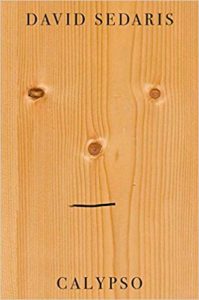David Sedaris “Calypso”
 David Sedaris’s latest collection of short stories Calypso is a wonderful example of his writing philosophy, to “use life material“. To make something out of nothing so that “the story often can be better“. The stories that are mostly set in the beach house on the Carolina coast which he means to share with his family and his friends.
David Sedaris’s latest collection of short stories Calypso is a wonderful example of his writing philosophy, to “use life material“. To make something out of nothing so that “the story often can be better“. The stories that are mostly set in the beach house on the Carolina coast which he means to share with his family and his friends.
There is a pall of gloom with some of the stories particularly the one’s in which he refers to his sister Tiffany who committed suicide. At one point he recounts the last time he saw his sister was when she wanted to come backstage to meet him after an event but he instructed the security guards to close the doors. It was the last time he saw her. His relationship with his Republican father is tense. Sedaris’s description of his father’s home and the difficult conditions he lives in because the patriarch wants to leave a neat inheritance for his childrenis brutal and unforgiving. His matter-of-fact confession of his mother being an alcoholic, a condition no one in the family wished to acknowledge or openly refer to, but which took her to the grave by the time she was 62. It is a disturbing thought for the author at the time of writing Calypso is a little shy of the very same age his mother was. Sedaris is 61. Yet despite the gloominess that seems to pervade the stories, the constantly shifting relationships of the remaining five Sedaris siblings, David and his partner of twenty five years host the family twice a year, during Thanksgiving and Christmas. The family plays board games, cooks together, walks along the beach and converses to while away the time.
The title story “Calypso” is about the benign tumour he had growing on his chest. It was surgically removed by a surgeon who came to hear Sedaris speak at a book event. While on stage he happened to make a reference to the lipoma and how no doctor was willing to surgically remove it and give the tumour to Sedaris. The reason for his wanting the lipoma is so utterly bizarre and yet he gets his way. He wants to feed it to the turtles that congregate by the beach house. It is a story that is utterly revolting to read and at the same time, unputdownable.
Sedaris comes across as someone who wants to be always in control. “I want to be acknowledged as a generous provider. This is about me, not them.” It is this exact same attitude which makes it perplexing about the narratives he chooses to share in Calypso. Apart from being the author, the creator, he is also the man who seems to be in control of the family portraits. For instance he is particularly unforgiving and vicious about his neice to whom he loses in board games but even though she is twelve years old, possibly with a strong personality and vocal as many tweens have, she is reduced to being more or less a silent character. What an unfortunate space to inhabit — to have a negative portrait of yourself known far and wide under the deft strokes of a well-known writer, who is also your uncle. Ouch! For example like this tiny instance of them playing “Sorry”.
I turned to Madelyn, who had drawn a ten and, instead of moving forward like a normal, sweet sixth-grader, employed the card’s other option and took one step back, thereby returning my pawn to start, though I posed no threat to her whatsoever.
“You will grow up to be a terrible person,” I told her. “I mean, more terrible then you are now. If that’s even possible.”
Sedaris’s dark humour takes one’s breath away! Be that as it may Calypso is a searing, perhaps even truthful, portrait of an ordinary family which happens to be his.
Read it.
6 September 2018

No Comments